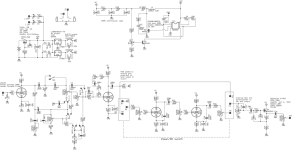Hi,
I'm writing because I'm planning on making a tube preamp pedal starting from a schematic I found, however it's my starting point with tubes (also thanks to @vigilante398 for the great 101 & 102 entry level guides ) at relatively high voltage and I would like to be as safe as possible, and regarding this it would be of a huge help to get some of your knowledge.
) at relatively high voltage and I would like to be as safe as possible, and regarding this it would be of a huge help to get some of your knowledge.
The schematic I'm looking at is this (not mine):
View attachment 65164
it's a ODS based preamp using 2 subminiature tubes. As you can see it runs via a 555 based SMPS (which should get between 150 and 200V). The guy that designed this is not reachable unfortunately, however he stated that the results were very nice.
My first big doubt is, I already have all of the components, but what is generally a safe way of testing/breadboarding it? I have read a lot of contrasting opinions in regards of high voltage breadboarding, some saying that the cheap solderless breadboards should work fine as long as keeping some distance between rows to prevent capacitance issue (however I don't feel very safe in doing so, no?), other saying there's no way they can handle 200 V.
What would be your way of testing the circuit before designing a proper PCB?
I though also at perf boards, but it also comes with some other draw backs.
Thanks a lot in case you can take the time to help me.
Best regards
I'm writing because I'm planning on making a tube preamp pedal starting from a schematic I found, however it's my starting point with tubes (also thanks to @vigilante398 for the great 101 & 102 entry level guides
The schematic I'm looking at is this (not mine):
View attachment 65164
it's a ODS based preamp using 2 subminiature tubes. As you can see it runs via a 555 based SMPS (which should get between 150 and 200V). The guy that designed this is not reachable unfortunately, however he stated that the results were very nice.
My first big doubt is, I already have all of the components, but what is generally a safe way of testing/breadboarding it? I have read a lot of contrasting opinions in regards of high voltage breadboarding, some saying that the cheap solderless breadboards should work fine as long as keeping some distance between rows to prevent capacitance issue (however I don't feel very safe in doing so, no?), other saying there's no way they can handle 200 V.
What would be your way of testing the circuit before designing a proper PCB?
I though also at perf boards, but it also comes with some other draw backs.
Thanks a lot in case you can take the time to help me.
Best regards


